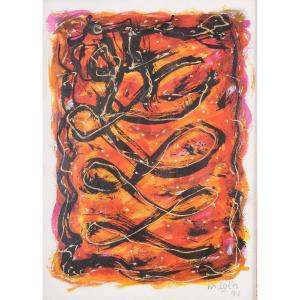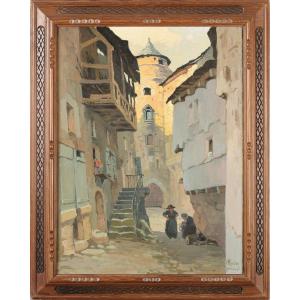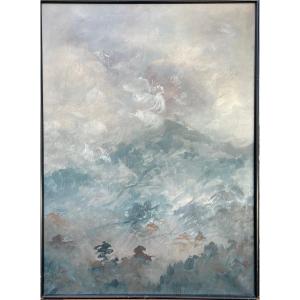(Périgueux 1851 - 1936)
L'Isle at Saint Léon sur L'Isle
Oil on panel
H. 37 cm; L. 28.5 cm
Signed and dated 1907 lower right. Countersigned and located on the back.
Provenance: Private collection, Loiret
Jean-Georges Pasquet was born in 1851, in Périgueux. After a very little documented Périgord childhood, the young artist arrived in Paris and joined the School of Fine Arts, from which he graduated a few years later. He returned to his land in 1879 to take over the management of the municipal drawing school of Périgueux, and also became a drawing teacher at the Normal Schools for boys and girls. Pupil of Gustave Boulanger, Jules Lefèvre and Jean-Joseph Benjamin-Constant, the painter places his easel on the banks of the Dordogne or the Isle to "tell a few memories" through realistic landscapes filled with softness. Through his style, the painter reveals a great idea to his compatriots, of his country and his origins. We find works devoid of artifice, representing the inhabitants of the region, working their land or simply strolling on paths. These paintings or drawings by Pasquet retrace the life of Périgord at dawn and during the 20th century, always located in very specific places. He is one of the artists of the School of Périgueux. This school, somewhat forgotten in the history of art, highlights the heritage and identity of the Perigord lands. Among the representatives, we find Jean-Louis Daniel, André Saigne, Georges Darnet, René Laforest, Roger Favard and André Prugent. This movement has as a common denominator a theme that stands out from the canons of the time: the landscape. “It's a school without a leader and without a dominant style, but which worked with extraordinary enthusiasm. They liked to attack pieces of nature that we call here picadis. » Jean-Michel Linfort The artist paints the Dordogne but not only, he travels to Creuse and very regularly to Saint Georges de Didonne. He paints the rivers, the sea, the ports, the bridges, the dunes and the forests there. So many motifs that he knows how to transcribe and to which he gives life thanks to the bright colors and the movement given to his brush, to give relief to the landscapes.
This view of the dyke of Saint Léon sur L'Isle is one of those very contrasting works that Pasquet is used to presenting. Vivid greens pop in the foreground of vegetation against grayish greens. A beautiful notion of depth opens up thanks to this clever technique, also bringing out the simmering water. The Isle here cut by the reservoir of a mill is one of the painter's favorite subjects, near Périgueux.
Warped panel with a crack on the back.




































 Le Magazine de PROANTIC
Le Magazine de PROANTIC TRÉSORS Magazine
TRÉSORS Magazine Rivista Artiquariato
Rivista Artiquariato